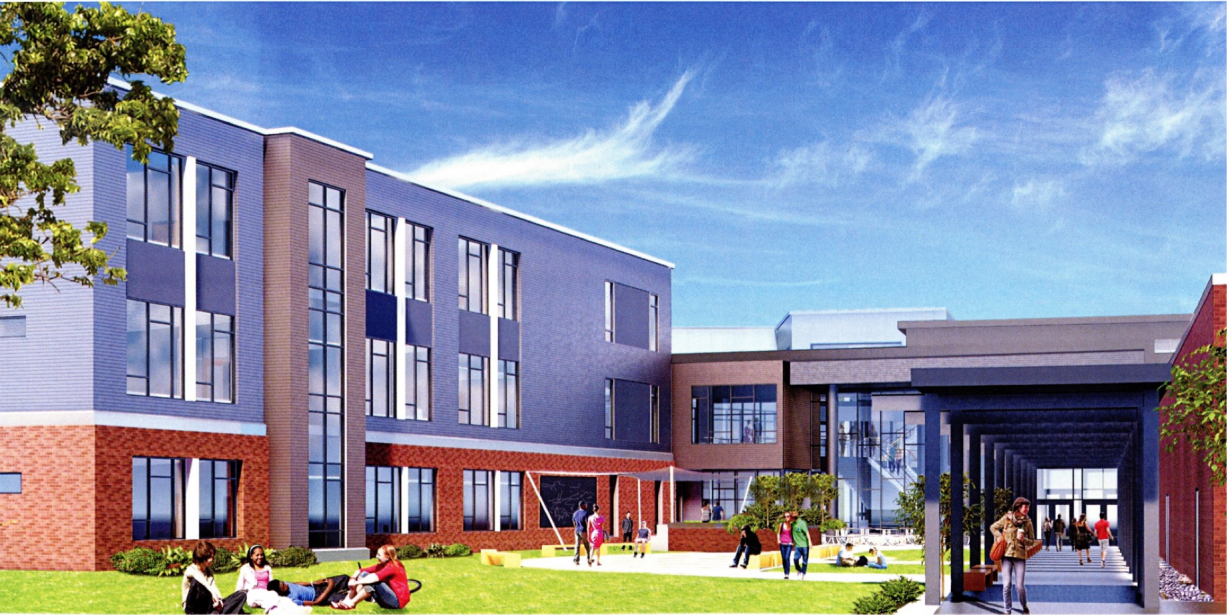By Randi B. Hagi, senior contributor
The new high school’s appearance, function and feel are starting to take shape in meetings of the school board-appointed design committee.
But other questions — such as how students will be divided between the two schools and whether each will offer the same programs — have ignited public debate, including at a public meeting May 23 and on Facebook.
A survey circulated by Adrienne Hooker, an assistant professor in JMU’s School of Media Arts and Design, provides a snapshot of that ongoing debate among Harrisonburg residents. Aside from a clear majority saying they wanted two separate schools, as opposed to considering them two campuses of the same school, respondents were largely split over many of the details, according to the results of the voluntary survey Hooker shared with The Citizen.
Hooker is a founding member of the grassroots organization For HHS2, a grassroots organization that formed in October 2017 to advocate for the construction of the new high school.
“We’re not going to disband or move on to other things until the high school is built and open,” Hooker said.
Hooker’s son is a rising ninth grader, which will make him part of the first graduating class from the two-high school system, if the new high school opens as planned in the fall of 2022.
After attending three of the meetings of the new school’s programming committee aimed at gathering input from subject-specific stakeholders, Hooker got permission from the architects’ and builder’s representatives to circulate those programming committee questions.
She published the survey on Google Forms in English, Spanish and Arabic starting May 22 – and received 104 responses.
Hooker said she felt there wasn’t enough of an opportunity for members of the public to provide input on the new school just through the May 23 public forum and an email address.
“You limit your input when you only offer things at a certain time,” Hooker said.
So far, the survey has generated 104 responses. One was in Spanish, the rest, English.
Hooker has sent the initial data to the architects, as well as the school board.
Some of the major themes from the survey responses include:
- Sixty-seven percent of respondents wanted two separate schools, rather than one school with two campuses. Deb Fitzgerald, the school board chair, told The Citizen last month that the two-campus concept is not viable.
- More than 55 percent of respondents said they want students to be sorted geographically, such as through the redistricting of Harrisonburg so that some students in neighborhoods closer to the new school between Main Street and I-81 will go there, while others closer to the existing high school on Garbers Church Road will go there. Other respondents preferred sorting by programs, and a few preferred that each middle school would funnel into a specific high school.
- Top programming priorities — in terms of classes and potential special focuses of each school — varied greatly, and not all survey respondents answered this question. Of the 78 responses concerning priorities, 19 percent mentioned offering the same classes or opportunities at both schools; 13 percent mentioned preparing students for adult life, including both a college education or work in certain trades.
- The Spanish-language respondent said it would be both a challenge and a potential success to hire good teachers that represent Harrisonburg’s multicultural population.
- Sixty-five respondents answered a question about which three key design features they most valued. Roughly 27 percent mentioned having green spaces, attractive landscaping and/or outdoor instructional space. Another 16.9 percent mentioned environmentally sustainable design elements. And 15 percent want the new high school to be built in a way that it could easily expand to accommodate future growth.
- In the survey’s “additional thoughts or comments” section, several respondents said they did not want excess money to be spent on making “pretty” spaces that would not be regularly used.
Nick Swayne, a school board member serving on the design committee, said in an email that the group is “getting closer” to deciding “on issues of what we wanted in each school, and what we wanted in both schools.”
School board member Obie Hill is also on the design committee. Hill told The Citizen in an email that the committee is methodically going through its process.
“We pooled all of the comments/suggestions for our new high school from the programming committee meetings and discussed the items that could be included in our new high school,” he said. “We realize that some of the things that were suggested in our programming meetings would not be fiscally possible as we are working with a budget.”
Solar schools program still in limbo
While some respondents to the survey cited environmentally sustainable design features in the new school as a priority, the plan to add a major solar panel development at the existing high school and four other schools remains in limbo. The project, when announced in December, was slated to be the largest solar development for a public school system in Virginia.
But Deb Fitzgerald, the school board’s chair, told The Citizen on Tuesday that “the school board continues to explore other options … about solar.”
She declined to provide any further comment about the solar energy project, which was to involve the company Secure Futures and was scaled down this spring while the school district, the company and the Harrisonburg Electric Commission negotiated over details of the financial and energy effects of the development.
Correction: Because of an editor’s error, the point about design features mistakenly said it was 65 percent of respondents. It was 65 respondents.
Journalism is changing, and that’s why The Citizen is here. We’re independent. We’re local. We pay our contributors, and the money you give goes directly to the reporting. No overhead. No printing costs. Just facts, stories and context. Thanks for your support.

